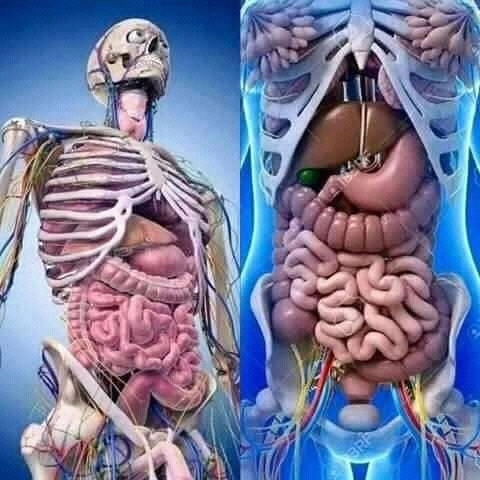Communications And EntertainmentNews And PoliticsStories And PoemsHealth And LifestyleArts And EducationBusiness And MoneyEntertainmentStoriesGeneralScience And TechnologyEducationRelationship And MarriageAgricultureNigerianewsIT And Computer ScienceFoodUSMLE And MedicalsPoemsNewsLifestyleAnnouncementMotivation
Victor21
Skilled Worker : Register With My Link
Wants to meet Just Friends
Articles
1876
Followers
136
profile/7509FB_IMG_16584340855903727.jpg
Victor21

Radiation Effects To Human Organs
~4.1 mins read
A wide variety of reactions occur in response to irradiation in the different organs and tissues of the body. Some of the reactions occur quickly, while others occur slowly. The killing of cells in affected tissues, for example, may be detectable within minutes after exposure, whereas degenerative changes such as scarring and tissue breakdown may not appear until months or years afterward.
In general, dividing cells are more radiosensitive than nondividing cells (see above Effects on the cell), with the result that radiation injury tends to appear soonest in those organs and tissues in which cells proliferate rapidly. Such tissues include the skin, the lining of the gastrointestinal tract, and the bone marrow, where progenitor cells multiply continually in order to replace the mature cells that are constantly being lost through normal aging. The early effects of radiation on these organs result largely from the destruction of the progenitor cells and the consequent interference with the replacement of the mature cells, a process essential for the maintenance of normal tissue structure and function. The damaging effects of radiation on an organ are generally limited to that part of the organ directly exposed. Accordingly, irradiation of only a part of an organ generally causes less impairment in the function of the organ than does irradiation of the whole organ.
Skin
Radiation can cause various types of injury to the skin, depending on the dose and conditions of exposure. The earliest outward reaction of the skin is transitory reddening (erythema) of the exposed area, which may appear within hours after a dose of 6 Gy or more. This reaction typically lasts only a few hours and is followed two to four weeks later by one or more waves of deeper and more prolonged reddening in the same area. A larger dose may cause subsequent blistering and ulceration of the skin and loss of hair, followed by abnormal pigmentation months or years later.
Bone marrow
The blood-forming cells of the bone marrow are among the most radiosensitive cells in the body. If a large percentage of such cells are killed, as can happen when intensive irradiation of the whole body occurs, the normal replacement of circulating blood cells is impaired. As a result, the blood cell count may become depressed and, ultimately, infection, hemorrhage, or both may ensue. A dose below 0.5–1 Sv generally causes only a mild, transitory depletion of blood-forming cells; however, a dose above 8 Sv delivered rapidly to the whole body usually causes a fatal depression of blood-cell marroon.
Gastrointestinal tract
The response of the gastrointestinal tract is comparable in many respects to that of the skin. Proliferating cells in the mucos membrance that lines the tract are easily killed by irradiation, resulting in the denudation and ulceration of the mucous membrane. If a substantial portion of the small intestine is exposed rapidly to a dose in excess of 10 Gy, as may occur in a radiation accident, a fatal dysentery-like reaction results within a very short period of time.
Reproductive organs
Although mature spermatozoa are relatively resistant to radiation, immature sperm-forming cells (spermatogonia) are among the most radiosensitive cells in the body. Hence, rapid exposure of both testes to a dose as low as 0.15 Sv may interrupt sperm-production temporarily, and a dose in excess of 4 Sv may be sufficient to cause permanent sterility in a certain percentage of men.
In the human ovary, oocytes of intermediate maturity are more radiosensitive than those of greater or lesser maturity. A dose of 1.5–2.0 Sv delivered rapidly to both ovaries may thus cause only temporary sterility, whereas a dose exceeding 2–3 Sv is likely to cause permanent sterility in an appreciable percentage of women.
Lens of the eye
Irradiation can cause opacification of the lens, the severity of which increases with the dose. The effect may not become evident, however, until many months after exposure. During the 1940s, some physicists who worked with the early cyclotrons developed cataracts as a result of occupational neutronirradiation, indicating for the first time the high relative biologic effectiveness of neutrons for causing lens damage. The threshold for a progressive, vision-impairing opacity, or cataract, varies from 5 Sv delivered to the lens in a single exposure to as much as 14 Sv delivered in multiple exposures over a period of months.
profile/7509FB_IMG_16584340855903727.jpg
Victor21

How To Save A Drowning Person.
~1.5 mins read
Reviving Someone Who Has Drowned or Swallowed Water
Learn how to properly revive a drowning victim.
First Things First:
If you suspect someone is drowning, notify a lifeguard and call for help. Do not waste anytime.
Rescue is only half the job. Reviving someone who has drowned or swallowed water is the other half, and it's equally important when it comes to saving a life.
More: Pool Safety for Kids
If you've pulled a drowning person back to dry land, the next step to reviving them is performing mouth-to-mouth resuscitation. As always, call for help before beginning these important first aid emergency measures.
You should implement universal safety guidelines whenever possible. If you have an airway bag in your first aid kit , use it! It will provide safety during mouth-to-mouth resuscitation, keeping HIV and other infections at bay.
Steps for Mouth-to-Mouth Resuscitation
1. Turn the drowning person's head to the side, allowing any water to drain from his or her mouth and nose. Turn the head back to the center.
2. Begin mouth-to-mouth resuscitation on land, if possible, or in the water if the injured person needs immediate life-and-death measures.
3. Strongly breathe four times into the mouth of the injured person as you pinch his or her nose. This helps air get past any water that is clogging the breathing passageways and the lungs.
4. After four strong breaths, put your ear near the mouth and watch the chest for any breathing movement.
5. Check the pulse for signs of life.
6. Repeat the cycle.
young girl at pool receiving CPR
What to Worry About Next:
You're not out of the water once the drowning victim starts to breathe and choke. In fact, the first 48 hours after a drowning incident can be the most dangerous. Complications resulting from water exposure—pneumonia, infection, heart failure—can all occur during this time. Therefore, you should always take a drowning victim to the hospital.
Advertisement

Link socials
Matches
Loading...
